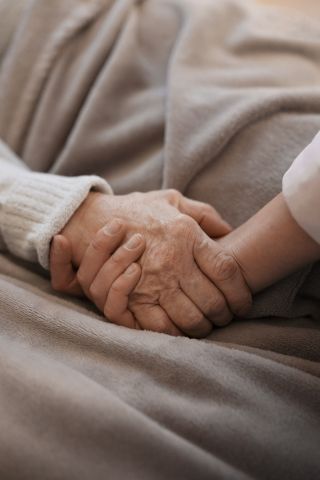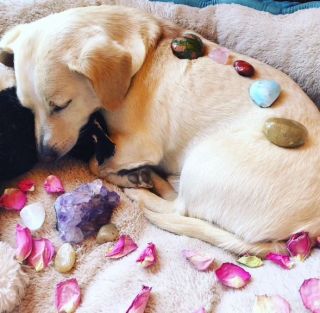Caregiving
What Is an End-of-Life Doula?
This emerging field of support honors death and dying for people and pets.
Posted March 31, 2024 Reviewed by Ray Parker
Key points
- A new field of coaching supports individuals and families with death and dying.
- An end-of-life doula can be called in before and during hospice or palliative care to guide.
- They facilitate conversations about death wishes, create a peaceful environment, and offer grief counseling.
- Pet ceremonies can create a healthy, positive relationship with the dying process for children and families.

While my family sits with our ailing father in the difficult time between life and death, my niece, Lindsey offered invaluable insight as a former hospice nurse. Her calm and open demeaner about the dying process, brought a palpable ease to the room. Upon hearing about her hospice experiences, I wanted to understand the role of a "death doula" and this new field of support.
"The appellation ‘end-of-life doula’ (EOLD) is increasingly used as an umbrella term to identify lay people, primarily women, who provide a diversity of non-medical supports—social, emotional, practical, and spiritual—for people nearing the end of life, including those close to them" (Krawzik and Rush, 2020). The term doula is derived from the Greek word "doule," which means helper or maidservant. Families hire death coaches to facilitate, guide, and emotionally support the dying process.
Nancy Telzerow, an end-of-life doula based in Ohio, says that she provides "a bridge to allay fears, communicate expectations, and gently walk individuals towards grace and peace with the dying journey, all while the spiritual veils are thin and close at heart.” Telzerow advised me to talk with my father continually, even when I am not physically with him. She suggested I share my excitement about his reunion with our loved ones who have passed. My Dad nodded and smiled when I mentioned that when we see an Irish flag wave, we will think of him.
The services provided by an EOLD may include:
1. Providing education and guidance regarding "do not resuscitate" orders and healthcare power of attorneys.
2. Creating an environment that allows for an open discussion about the dying process.
3. Supporting the patient's preferences in terms of environment and visitation.
4. Working alongside hospice and palliative care to ensure patient comfort.
5. Respecting the individual's faith practices and offering spiritual support.
6. Sitting with the patient and family during the final moments.
7. Providing supplemental grief counseling.
8. Assisting with funeral arrangements and exploring ways to share the individual's life and legacy following death.
Another EOLD, Ra Johnlynn, considers the window between life and death as a sacred opportunity. She notes that, similar to baby’s birth, “Only a select few are invited to witness and join the miracle.” Johnlynn sees her role as connecting the subtle energies and emotions of the individual and their family by creating a safe, grounded, reflective, and nurturing environment. She believes that just like time spent bonding with a newborn, this liminal time allows us to be more fully present with the soul or enduring essence of the person.
Nothing else matters, and there is nothing to be done except to sit with the presence inherent in each passing moment of passing. Johnlynn helps families welcome death with honor and reverence, trusting that the individual, whether awake or asleep, knows what is happening. In this way, she shares, “The beauty of death is reframed as a transformational teacher for all involved.”
Joyce’s Story
Joyce knew she was dying. Her 74-year-old body was rapidly deteriorating as the cancer spread. She was terrified to die. Her family found her anxiety unsettling, and in a hope for peace and, at the very least, acceptance, they called in Ivana Ustaritz, a death doula based in Boston.
At the initial meeting, Ustaritz explained to Joyce's daughter that her job would be to ease Joyce's anxiety, advocate for her wants and needs, and support the family in this challenging transition.
At first, Ustaritz rubbed Joyce's feet and hands with essential oils, encouraging her system to relax. Ustaritz asked gentle questions, allowing Joyce to express her fears. Ustaritz supported Joyce in connecting her impending death with the beautiful threads of life including the faith she had always carried deep within. Some days, Ustaritz would invite the connection through the breath. The air Joyce breathes automatically comes and goes, filling her body. Ustaritz says,
"To sit with death, we sit in stillness. Here, everything settles into the presence beyond emotions. It is. We meet each inhale as we do life and each exhale as we do death. The pauses in between are where there is no difference."
Pet Passing

Johnlynn also offers support to families as an end-of-life ceremonialist for pets, helping navigate the loss and grief. She believes that emotions are simplified with our pets because there is no “story” or pretense in the relationship. We more easily support their passing as a natural process. This shift in perspective invites the question, “How would you support your pet in having their very best last days with you? What could that look like?”
Johnlynn assisted one particular family in honoring their precious dog, prior to her passing. She facilitated two initial sessions with the parents and children to discuss death and where everyone thought the dog's soul and body would rest. The family shared stories about their furry friend. They talked about their dog's favorite treats, toys, and spots in the home, so that each family member could consciously gift these to their pet in her final days.
Together, they decided on a resting place for the dog and how they would honor her body by creating an outdoor memorial. In a follow-up session, the family joined Johnlynn in celebrating both life and after-life so that it was not anything feared. All emotions were allowed and expressed. The family pictured the pet's crossing as a welcome to heaven, and they memorialized the passage with flowers, crystals, songs, memories, tears, and hugs.
Johnlynn believes these pet ceremonies can help individuals develop a healthier relationship with death as a fluid, connecting, and intuitive process. “When we learn to support the transition with our pets in positive ways, we can apply that understanding to human death so we can receive the medicinal teachings of the death field more readily.”
Conclusion
I am so grateful to learn these perspectives while I honor the gifts of my beloved Dad’s life and death journeys.
References
Krawczyk, M & Rush, M. Describing the end-of-life doula role and practices care: perspectives from four countries. Journal of Palliative Care and Social Practice, 2020; 14:263235242097322.
Thank you to Lisa McCarthy who lovingly shared Joyce's story and the gifts Ivana provides. Thank you to all my doula friends who graciously offered their care and wisdom for me, my family, and this article.




